Archived content
NOTE: this is an archived page and the content is likely to be out of date.
Environmental Activities in Factories
We work to comprehensively lower the environmental burden of factories making products for the Fujitsu Group.
Approach to Reducing Burdens at the Factory
The Fujitsu Group continually strives to reduce the quantities of materials, water resources, and energy used at its factories, as well as the amounts of chemicals and waste materials generated and atmospheric pollutants emitted, while trying to minimize manufacturing costs. It also takes a rigorous approach to complying with laws and regulations and eliminating environmental risks.
Development of Green Production Technology
Assembly, processing and other production-related processes and equipment account for roughly 40% of overall CO2 emissions at Fujitsu factories. In a move to cut energy consumption associated with production, we are working to visualize power usage particularly around surface mount technology (SMT), assembly and testing processes. Improvements are then implemented beginning with processes and facilities where the most efficient reductions in power consumption are possible.
![]()
Cutting Electricity Consumption by Insulating Electric Heaters
PFU TechnoWise Limited, a manufacturer of scanners and information kiosk terminals for the Fujitsu Group, works with Fujitsu's Monozukuri Development Unit(Production Promotion Unit) to develop green manufacturing technologies, including ones that reduce electricity usage, for saving energy. In May 2012, they came up with a way to greatly reduce the amount of electricity used by aging tents, which are used in the manufacturing of information kiosk terminals and evaluate the reliability of products under high heat.
In a traditional aging tent, an electric heater positioned at the top takes in and heats outside air to keep the inside of the tent at 40℃. Air pressure inside the tent, therefore, is higher than outside, and warm air leaks from the bottom and sides. That the heater must replace the amount of warm air leaked means energy efficiency is very bad. To improve upon this situation, the electric heater was covered with an insulated box, causing the warm air inside the tent to recirculate through the heater. This relieved the difference in air pressure, eliminating the warm air leakage, and, because the recirculation of warm air improved the operating efficiency of the heater, the amount of electricity needed to keep the redesigned tent at 40℃ was reduced. Measurements show that an improved aging tent uses only 0.325kWh, less than a quarter (more specifically, a 76.7% savings) of the 1.4kWh used by a traditional model. In February 2013, this initiative was one of 60 energy-saving activities that were recognized with an award for outstanding energy management at the 2012 Ishikawa Energy-Saving promotion convention.
Moving forward, we will continue with efforts to steadily save energy with changes to air conditioning facilities, exhaust ducts, and other improvements within manufacturing plants.
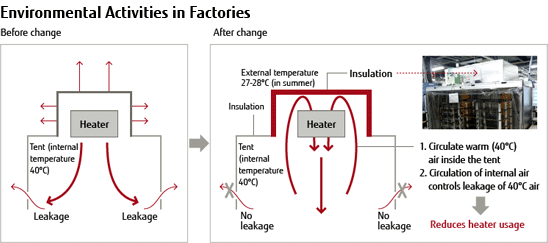
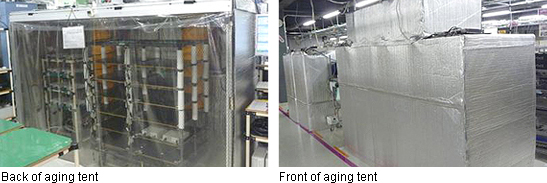
![]()
Low-Melting-Point Lead-Free Solder for Environmentally Friendly Product Manufacturing

Fujitsu IT Products Limited, which makes server products, had adopted the use of lead-free solder to comply with the RoHS Directive for UNIX servers. The solder, however, had a high melting point of over 200℃, meaning that the heater for the solder furnace had to be kept at a high temperature and large amounts of electricity were consumed.
To improve upon this situation, the lead-free solder was fundamentally changed to a low-melting-point solder composed of zinc, bismuth, and silver. With this newsolder, which has a melting point of only 139℃, the solder furnace can be kept at a lower temperature and electricity consumption for the furnace heater has been reduced by 39%. That means an annual energy cost saving of about 740,000 yen and CO2 reduction of around 14 tons. This low-melting-point lead-free solder is now being planned for use on IA servers and mainframes.
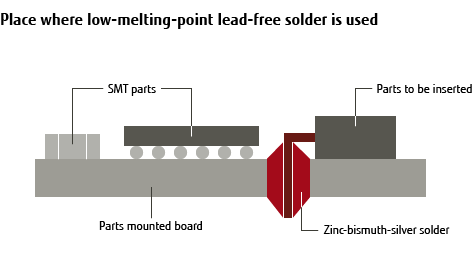
Reducing the Amount of Waste Generated
Basic Approach
Working towards a recycling-minded society, our 3R*1 policy encourages all employees to separate waste materials into different categories for effective recycling.
*1 3R:
Reduce, Reuse, and Recycle
FY 2012 Performance
In the Fujitsu Group Environmental Protection Program (Stage VI), we set the goal of reducing the amount of waste business operations generated by 20% compared to FY 2007 levels by the end of FY 2012.
We generated 27,353 tons of waste (per unit of actual sales: 6.2 tons/billion yen) in FY 2012, which was a 3.8% reduction from the previous fiscal year's level and a 29.6% reduction from the FY 2007 level. The Fujitsu Group Environmental Protection Program (Stage VI) target of a 20% reduction from the FY 2007 level, therefore, was achieved. The reasons for these reductions include the conversion of waste paper and cardboard to valuable materials, and the partial introduction of in-house processing of flux cleaning solvent.
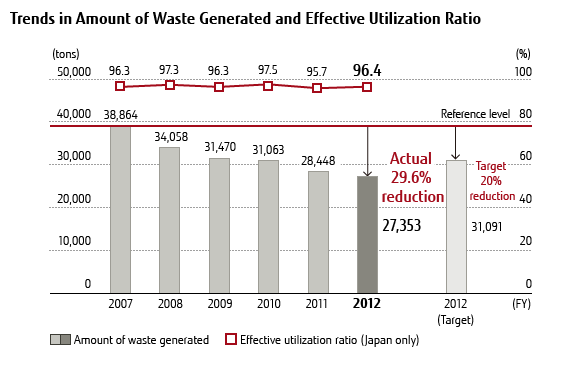
| Waste Type | Waste Generated | Effective Utilization | Final Disposal |
|---|---|---|---|
| Total | 27,353 | 25,346 | 2,007 |
| Sludge | 4,377 | 4,298 | 79 |
| Waste oil | 1,863 | 1,862 | 0.4 |
| Waste acid | 3,728 | 3,725 | 3 |
| Waste alkali | 3,388 | 3,386 | 2 |
| Waste plastic | 4,046 | 3,955 | 91 |
| Waste wood | 1,306 | 1,306 | 0 |
| Metal waste | 517 | 515 | 2 |
| Glass/ceramic waste | 288 | 288 | 0 |
| Other *2 | 7,839 | 6,010 | 1,829 |
*2 Other:
Other includes general waste, paper waste, septic tank sludge, residues, rubble, textile waste, animal and plant residue, and infectious waste.
![]()
Partial Introduction of In-House Processing of Flux Cleaning Solvent
At Shinko Electric Industries Co. Ltd., the cleaning fluid (type of ethylene glycol) used in a cleaning process to remove flux from products was being disposed of as industrial waste.
Switching the discharge destination of industrial wastewater to the sewer system from a river made it possible to process a portion (47%) of the liquid waste in-house and reduce industrial waste discharges by approximately 300 tons per year.
Annual savings in processing expense, meanwhile, came to about 3.4 million yen.
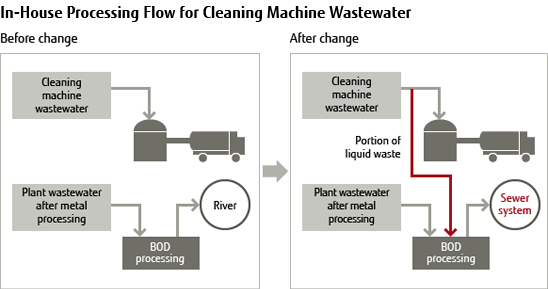
Achieving Zero Emissions at Domestic Group Companies
The Fujitsu Group promotes zero emissions*3 activities at Group companies in Japan. Zero emissions status was not achieved at some locations. We will continue considering ways to achieve zero emissions at these locations.
*3 Zero emissions:
Refers to effectively using 100% of waste and eliminating waste earmarked for landfills or simple incineration.
The Waste Targets of the Fujitsu Group Environmental Action Plan (Stage VII)
Fujitsu has already marked significant achievements in reducing waste. As ongoing management targets, therefore, we will work to reduce waste to less than the average level of 2007-2011 (31,134tons) and to continue zero emission activities among Japanese plants.
Effective Use of Water Resources
Basic Approach
We are continuously working to recirculate and reuse industrial water through approaches such as pure water recycling and rainwater use. In the Fujitsu Group Environmental Action Plan (Stage VII), which we have begun to implement in FY 2013, we have established effective water usage as a new goal and have taken steps like having overseas sites set their own quantitative targets for reducing water usage in an effort to do even more than we have in the past to use water effectively.
Results for FY 2012
Our water use for FY 2012 was 19,863 thousand cubic meters (per unit of actual sales: 4,530cubic meters/billion yen). This was 8.9% lower than FY 2011 and 8.2% lower than FY 2010. The ratio of recycled water to water use was 26.9% in FY 2012, which was about the same level as the 26.6% ratio in FY 2011.
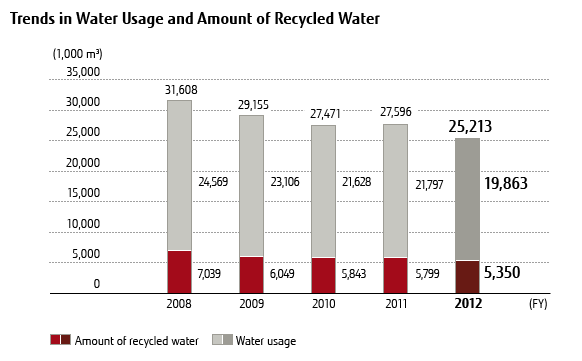
The Water Resource Targets of the Fujitsu Group Environmental Action Plan (Stage VII)
Fujitsu has traditionally and consistently pursued the effective use of water resources. However, with rising international interest in water resources, we decided that it was necessary to take our activities to an even higher level. Working toward the objective of efficient use of water resources, through approaches like water recycling and water saving, we are working to achieve an even higher level of effective water use.
![]()
Reduced Water Use at Fujitsu Australia
In Australia, the driest inhabited area of the earth, climate change has given rise to severe drought and other problems making water use a critical issue in realizing a sustainable society.
Though ICT industries do not use extremely large volumes of water, they must still endeavour to use water efficiently. At Fujitsu Australia, the datacenter is the primary consumer of water, over half of which is used for cooling. Since energy and water usage are correlated, increasing the datacenter's energy efficiency resulted in reduced water consumption. Fujitsu Australia is also using rainwater collected from its grounds to water its property and gardens, flush toilets, and provide cooling in its datacenter's closed-loop cooling system.
At The Gauge, a building housing Fujitsu Australia offices, 2.4 million liters of water from a sewage treatment system are reused annually. The building is equipped with many other environmentally friendly features and has won a six-star Green Star rating, the highest available in this Australian environmental architecture rating system.
Chemical Substances Management
Basic Approach
Prevention of environmental risks that could lead to environmental pollution or adverse health effects due to the use of harmful chemical substances has been established as our basic policy for chemical substances management. We manage the amounts used for about 1,300 chemicals, and we work to reduce the amount discharged and implement appropriate management at every business site.
Results for FY 2012
We set the goal of reducing emissions of specific chemical substances by 10% compared to FY 2007 by FY 2012 in the Fujitsu Group Environmental Protection Program (Stage VI).
Emissions of specific chemical substances by the whole Fujitsu Group in Japan in FY 2012 were 96 tons (4.7% reduction from FY 2011), which was a 62% reduction compared to the FY 2007 reference year. The goal of achieving a 10% reduction compared to FY 2007, therefore, was achieved.
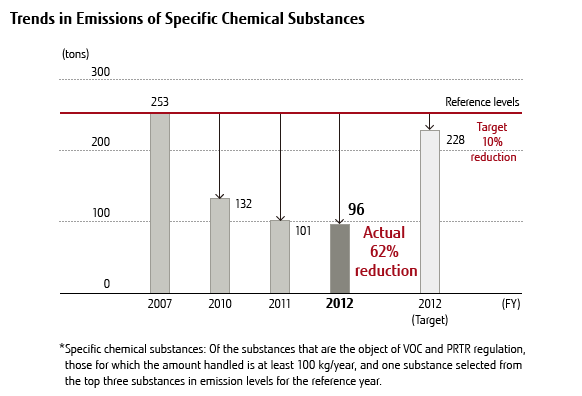
The Chemical Substance Targets of the Fujitsu Group Environmental Action Plan (Stage VII)
Fujitsu has already marked significant achievements in reducing chemical emissions. As ongoing management targets, therefore, we will work to reduce chemical emissions to less than the average level of 2009-2011 (PRTR: 21t, VOC: 258t)
Compliance with the Revised Chemical Management Law
Following revisions to the Chemical Management Law*4, more chemical substances are now covered by the MSDS*5 system and the PRTR*6 system (revisions applied to the MSDS system from October 2009, and to the PRTR system from April 2010).
Responding to these revisions, the Fujitsu Group has asked its suppliers to cooperate in the delivery of chemicals, and based on the revised PRTR system it is carrying out initiatives to obtain an accurate grasp of the amounts of chemicals transported and emitted. In FY2012, emissions of chemical substances covered by the PRTR system were 22 tons, and per unit of actual sales were 5.0kg/billion yen).
*4 Chemical Management Law:
A law to promote correct understanding, management, and reporting of amounts of designated chemicals emitted into the environment
*5 MSDS:
A system that requires attachment of a Material Safety Data Sheet to chemical deliveries
*6 PRTR:
Abbreviation of Pollutant Release and Transfer Register. This system requires the registration and reporting of data relating to the emission of harmful chemicals into the environment and volumes within transported waste.
Operation of "FACE," the Chemical Information System
The Fujitsu Group operates a Chemical Information System called "FACE." It can be used not only to register and monitor chemicals at every site but also to manage MSDS and control income and expenditure in conjunction with purchasing data and inventory data, FACE is helping the Group to strengthen its chemicals data and make it more efficient.
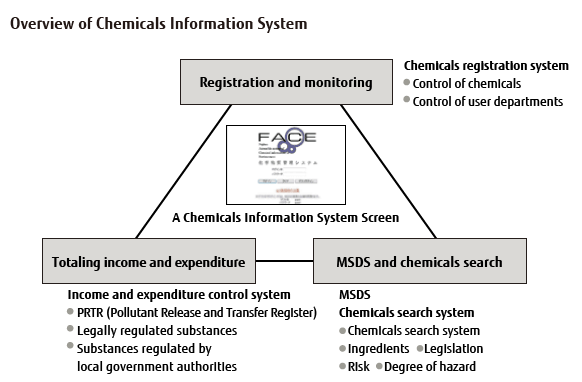
Preventing Air and Water Pollution
Preventing Air Pollution
We have set voluntary controls that are more stringent than emissions standards under related laws and ordinances in order to prevent air pollution and limit acid rain. Regular measurement and monitoring is conducted based on these controls. Efforts are made to appropriately process sulfur oxide, nitrogen oxide and other harmful substances and reduce emissions through measures such as controlling incineration at facilities that emit smoke, using fuels with low sulfur content, and managing operations at exhaust gas processing facilities. Furthermore, an absorption system using activated charcoal has been introduced to reduce the atmospheric discharge of organic solvent vapors containing substances like VOCs.
In addition, emission of dioxins has been prevented by suspending use of (completely phasing out) all in-house incineration facilities as of January 2000.
Preventing Water Pollution
In order to preserve the water quality of surrounding waterways, including rivers, groundwater and sewers, we have set voluntary controls that are even tougher than related laws and ordinances and conduct regular measurement and monitoring on this basis. We separately recover and recycle chemicals used in production processes, instead of discharging them into wastewater. And we are working to appropriately process harmful substances and other regulated substances (COD, BOD, etc.) and reduce discharges of them by ensuring appropriate chemical use, preventing chemical leaks and permeation, and properly managing the operations of water treatment and purification facilities, among other measures.
Preventing Ozone Layer Depletion
Elimination of Ozone-depleting Substances
The Fujitsu Group has completely eliminated use of ozone-depleting substances in manufacturing processes (parts cleaners and solvents) by utilizing precision aqueous cleaning systems and no-clean soldering technologies. Refrigerant CFCs used in air conditioning equipment (freezers, etc.) are being replaced with non-CFC refrigerants when equipment is upgraded, and measures are also taken to prevent leaks.
| Ozone-depleting substance | Date of elimination |
|---|---|
| Cleaning freons (CFC-113, CFC-115) | End of 1992 |
| Carbon tetrachloride | End of 1992 |
| 1,1,1-trichloroethane | End of October 1994 |
| Substitute freons (HCFCs) | End of March 1999 |
Environmental Liabilities
The Fujitsu Group, in properly forecasting environmental liabilities and communicating our soundness and stance of not deferring environmental liabilities, has recorded a liability of 8.28 billion yen in soil-pollution cleanup costs, high-level polychlorinated biphenyl (PCB) waste disposal costs, and asbestos processing costs during facilities demolition. This total is the amount we calculate, as of the end of FY 2012, to be necessary for the Fujitsu Group in Japan to carry out these tasks.
For processing waste with high levels of PCBs (transformers and capacitors), we have registered in advance with Japan Environmental Safety Corporation (JESCO), which processes PCB waste under Japanese government supervision, and perform this processing based on JESCO plans.

